How do we know that our occupational therapists are succeeding in inclusive education? Thomasian OTs craft competency matrix
Ensuring inclusive education program success requires an evaluation of the…

The University pulsates with youthful life. UST students number anywhere between 42,000 to 44,000 students, where some 12,000 are freshmen. Seen on campus are different manifestations of academic life from students whose backs are stooped while making sketches of University landmarks for their course requirements, to those whose eyes are glued on the pages of their books and e-books, reading intently for class, and the students who tirelessly rehearse dance steps for their physical education practical exams. Others are either on their way to or from class, walking with friends or just by themselves, traversing the two-way streets named after the University’s illustrious alumni.
Not everything on campus, however, is solely about the Thomasians’ academic development because the University’s goal is to provide them with holistic formation. Students are also immersed in community development activities that take place in campus, such as the annual Pistang Tomas Community Trade Fair usually held at the Quadricentennial Square in December. Food and other indigenous products of the partner communities and organizations are put on sale. This is not only a venue for students to help the partner communities, and interact with their members, but also this becomes an avenue for inculcating the values of social responsibility. Eventually, these students will take conscious efforts to transform society.
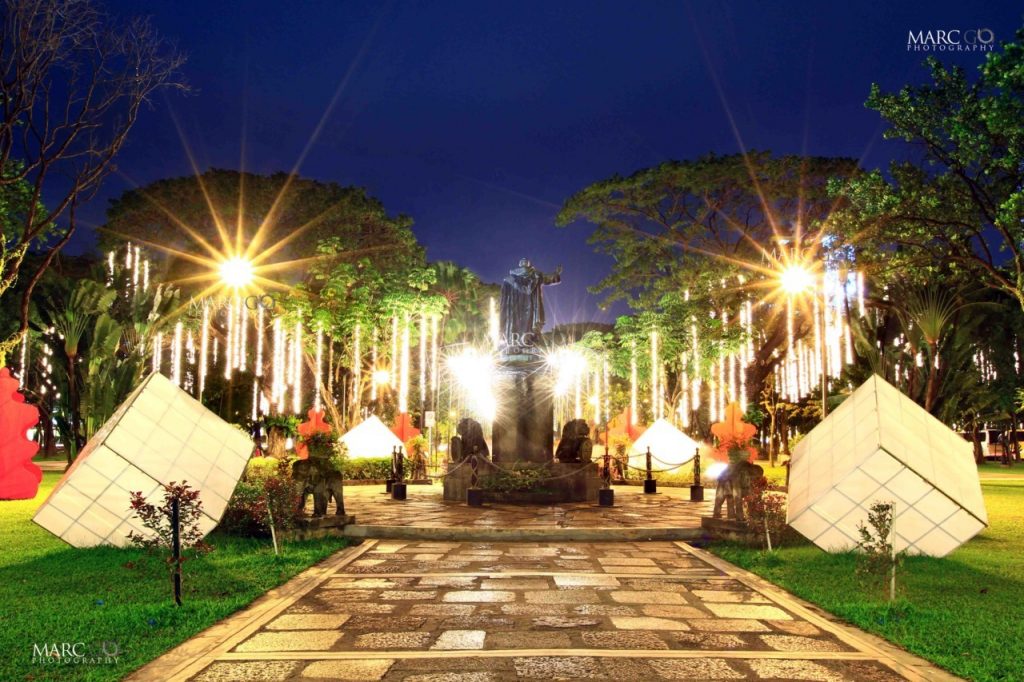
In December, the UST Grandstand and the Open Field become the site of ‘Paskuhan’. It starts with the Panunuluyan–the search of Joseph and Mary for the inn where Jesus was to be born. This is followed by the concelebrated Christmas Mass which usually coincides with the beginning of the Misa de Gallo. A program featuring mainstream live bands ensue, and the celebration ends with the much-anticipated fireworks display.
In May, graduating students gather at the Grandstand for the Baccalaureate Mass. After the Eucharistic celebration are post-Mass activities that include the blessing and imposition of the Thomasian Mission Cross, the recitation of the Thomasian Pledge of Loyalty, and the Ceremony of the Light. This is followed by the fireworks display and the send-off rites where the Rector and the Secretary General lead the candidates for graduation in passing through the Arch of the Centuries. This time, the students symbolically “leave the University” by walking through the Arch facing España Blvd. This is a symbolic act of their “readiness to face the challenges of professional life and fulfill the mission of serving the Church, the nation and the family as future Thomasian professionals.”
The landscaped open spaces known as Benavides Garden which starts from the Benavides Monument and ends at the Arch of the Centuries, the Plaza Mayor fronting the Main Building, the Quadricentennial Square found between the Main Building and the Benavides Library – all are teeming with students exhibiting mixed emotions of happiness and anxiety, but are generally excited about prospects of a new day in class or off-campus, confident that today’s inputs reached after hours of group practice or study will merit a positive outcome.
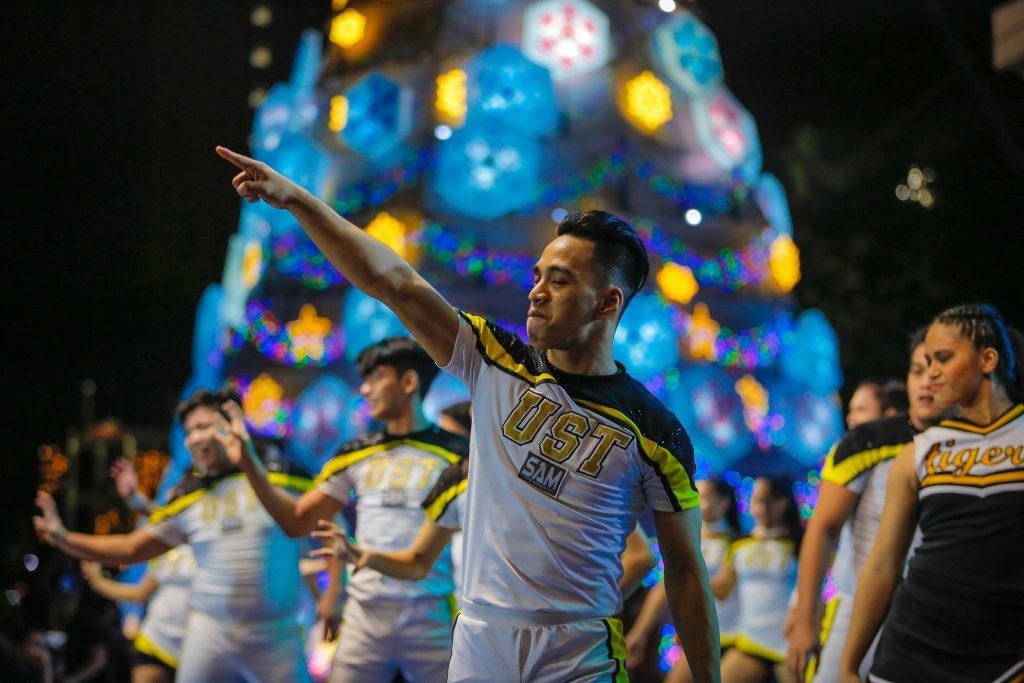
“There is more fun in UST!” Fun activities also take place in España. Freshmen curiously visit the student organization booths lined up at the Plaza Mayor, and look into groups that will match their interest, skills and needs through ‘Recruitment 101’ that takes place every first month of the academic year. Before the academic year ends, graduating students flock to the Benavides Plaza to take part in the annual Job Fair where more than a hundred companies join. Graduating students eagerly check out company booths for schedules of company orientation and go over glossy company flyers, brochures being distributed, excited over potential employers.
Aside from fun activities are religious and historical events. In August, freshmen take the traditional “Freshmen Welcome Walk” by passing through the Arch of the Centuries as a symbol of ‘becoming Thomasians’ because the same Arch was the doorway of the University when it was still in Intramuros. This is called the “Rite of Passage.”
This culminates in the traditional concelebrated Mass where the Rector himself presides and takes the opportunity to personally welcome the new set of UST students.
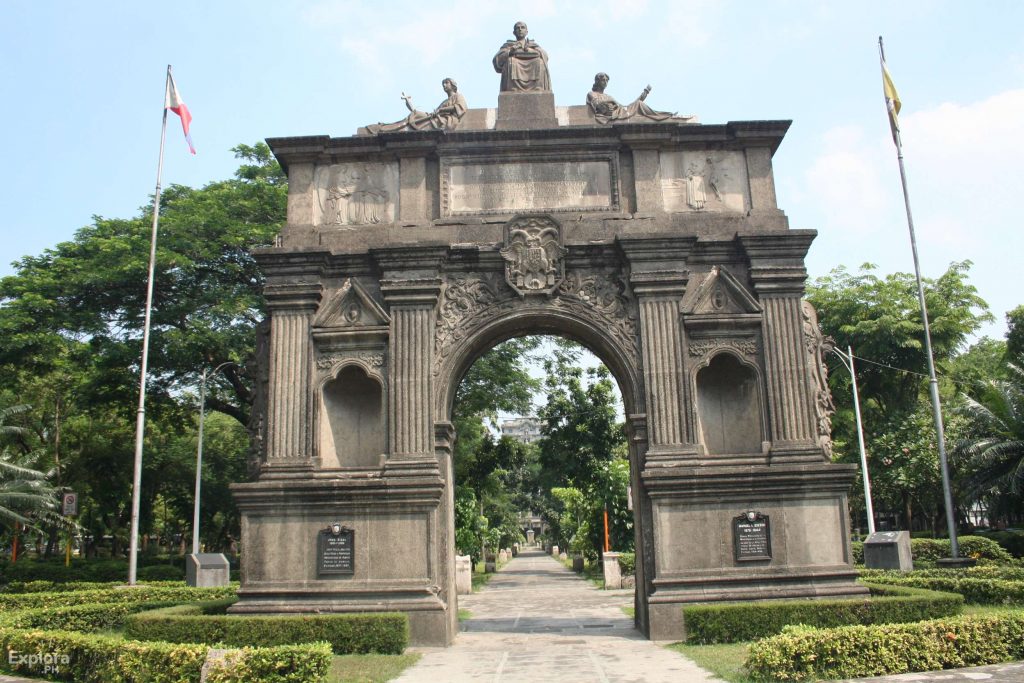
The University pulsates with youthful life. UST students number anywhere between 42,000 to 44,000 students, where some 12,000 are freshmen. Seen on campus are different manifestations of academic life from students whose backs are stooped while making sketches of University landmarks for their course requirements, to those whose eyes are glued on the pages of their books and e-books, reading intently for class, and the students who tirelessly rehearse dance steps for their physical education practical exams. Others are either on their way to or from class, walking with friends or just by themselves, traversing the two-way streets named after the University’s illustrious alumni.
Not everything on campus, however, is solely about the Thomasians’ academic development because the University’s goal is to provide them with holistic formation. Students are also immersed in community development activities that take place in campus, such as the annual Pistang Tomas Community Trade Fair usually held at the Quadricentennial Square in December. Food and other indigenous products of the partner communities and organizations are put on sale. This is not only a venue for students to help the partner communities, and interact with their members, but also this becomes an avenue for inculcating the values of social responsibility. Eventually, these students will take conscious efforts to transform society.

In December, the UST Grandstand and the Open Field become the site of ‘Paskuhan’. It starts with the Panunuluyan–the search of Joseph and Mary for the inn where Jesus was to be born. This is followed by the concelebrated Christmas Mass which usually coincides with the beginning of the Misa de Gallo. A program featuring mainstream live bands ensue, and the celebration ends with the much-anticipated fireworks display.
In May, graduating students gather at the Grandstand for the Baccalaureate Mass. After the Eucharistic celebration are post-Mass activities that include the blessing and imposition of the Thomasian Mission Cross, the recitation of the Thomasian Pledge of Loyalty, and the Ceremony of the Light. This is followed by the fireworks display and the send-off rites where the Rector and the Secretary General lead the candidates for graduation in passing through the Arch of the Centuries. This time, the students symbolically “leave the University” by walking through the Arch facing España Blvd. This is a symbolic act of their “readiness to face the challenges of professional life and fulfill the mission of serving the Church, the nation and the family as future Thomasian professionals.”
The landscaped open spaces known as Benavides Garden which starts from the Benavides Monument and ends at the Arch of the Centuries, the Plaza Mayor fronting the Main Building, the Quadricentennial Square found between the Main Building and the Benavides Library – all are teeming with students exhibiting mixed emotions of happiness and anxiety, but are generally excited about prospects of a new day in class or off-campus, confident that today’s inputs reached after hours of group practice or study will merit a positive outcome.

“There is more fun in UST!” Fun activities also take place in España. Freshmen curiously visit the student organization booths lined up at the Plaza Mayor, and look into groups that will match their interest, skills and needs through ‘Recruitment 101’ that takes place every first month of the academic year. Before the academic year ends, graduating students flock to the Benavides Plaza to take part in the annual Job Fair where more than a hundred companies join. Graduating students eagerly check out company booths for schedules of company orientation and go over glossy company flyers, brochures being distributed, excited over potential employers.
Aside from fun activities are religious and historical events. In August, freshmen take the traditional “Freshmen Welcome Walk” by passing through the Arch of the Centuries as a symbol of ‘becoming Thomasians’ because the same Arch was the doorway of the University when it was still in Intramuros. This is called the “Rite of Passage.”
This culminates in the traditional concelebrated Mass where the Rector himself presides and takes the opportunity to personally welcome the new set of UST students.

The University pulsates with youthful life. UST students number anywhere between 42,000 to 44,000 students, where some 12,000 are freshmen. Seen on campus are different manifestations of academic life from students whose backs are stooped while making sketches of University landmarks for their course requirements, to those whose eyes are glued on the pages of their books and e-books, reading intently for class, and the students who tirelessly rehearse dance steps for their physical education practical exams. Others are either on their way to or from class, walking with friends or just by themselves, traversing the two-way streets named after the University’s illustrious alumni.
Not everything on campus, however, is solely about the Thomasians’ academic development because the University’s goal is to provide them with holistic formation. Students are also immersed in community development activities that take place in campus, such as the annual Pistang Tomas Community Trade Fair usually held at the Quadricentennial Square in December. Food and other indigenous products of the partner communities and organizations are put on sale. This is not only a venue for students to help the partner communities, and interact with their members, but also this becomes an avenue for inculcating the values of social responsibility. Eventually, these students will take conscious efforts to transform society.
“There is more fun in UST!” Fun activities also take place in España. Freshmen curiously visit the student organization booths lined up at the Plaza Mayor, and look into groups that will match their interest, skills and needs through ‘Recruitment 101’ that takes place every first month of the academic year. Before the academic year ends, graduating students flock to the Benavides Plaza to take part in the annual Job Fair where more than a hundred companies join. Graduating students eagerly check out company booths for schedules of company orientation and go over glossy company flyers, brochures being distributed, excited over potential employers.
Aside from fun activities are religious and historical events. In August, freshmen take the traditional “Freshmen Welcome Walk” by passing through the Arch of the Centuries as a symbol of ‘becoming Thomasians’ because the same Arch was the doorway of the University when it was still in Intramuros. This is called the “Rite of Passage.”
This culminates in the traditional concelebrated Mass where the Rector himself presides and takes the opportunity to personally welcome the new set of UST students.
In December, the UST Grandstand and the Open Field become the site of ‘Paskuhan’. It starts with the Panunuluyan–the search of Joseph and Mary for the inn where Jesus was to be born. This is followed by the concelebrated Christmas Mass which usually coincides with the beginning of the Misa de Gallo. A program featuring mainstream live bands ensue, and the celebration ends with the much-anticipated fireworks display.
In May, graduating students gather at the Grandstand for the Baccalaureate Mass. After the Eucharistic celebration are post-Mass activities that include the blessing and imposition of the Thomasian Mission Cross, the recitation of the Thomasian Pledge of Loyalty, and the Ceremony of the Light. This is followed by the fireworks display and the send-off rites where the Rector and the Secretary General lead the candidates for graduation in passing through the Arch of the Centuries. This time, the students symbolically “leave the University” by walking through the Arch facing España Blvd. This is a symbolic act of their “readiness to face the challenges of professional life and fulfill the mission of serving the Church, the nation and the family as future Thomasian professionals.”
The landscaped open spaces known as Benavides Garden which starts from the Benavides Monument and ends at the Arch of the Centuries, the Plaza Mayor fronting the Main Building, the Quadricentennial Square found between the Main Building and the Benavides Library – all are teeming with students exhibiting mixed emotions of happiness and anxiety, but are generally excited about prospects of a new day in class or off-campus, confident that today’s inputs reached after hours of group practice or study will merit a positive outcome.
The University of Santo Tomas believes that Thomasians can play an active role in nation-building by being leaders in their respective spheres of influence. As such, the Office of Student Affairs implements the Saint Thomas Young Leaders’ Engagement Initiatives (STYLE-I), a holistic leadership training program for students.
Rationale
Advocating a seamless learning environment, the Saint Thomas Young Leaders Engagement Initiatives (STYLE I) is groundwork to the ever-changing landscape of youth profile brought about by the socio – cultural, economic, political, and technological forces in the environment. Recognizing the advent of globalization and the challenges it poses for the young Filipino professionals to succeed, the STYLEi creates opportunities for the students to succeed in their studies and life and become future leaders.
It was created by the Office for Student Affairs in 2011 as a learning development program of the University for the Thomasian students and the organization advisers.
Strategic Objective
To promote and ensure student academic achievement and life success through responsive and empirical based services of global standards
Program Intended Learning Outcomes
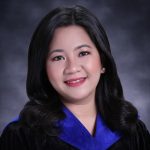
Asst. Prof. Jaezamie V. Ong, MA
Officer-in-Charge

Asst. Prof. Maria Cecilia A. Tio Cuison, MEd
Director

Asst. Prof. Maria Regina P. Arriero, MEng
Assistant Director
Student Welfare and Development Coordinators
Atty. Kenneth Lloyd G. dela Cruz, Ll. B.
UST AMV College of Accountancy
Asst. Prof. Carlos Angelo D. Aguilar, MAURP
College of Architecture
Asst. Prof. Emelito F. Sarmago, MEd
Faculty of Arts and Letters
Prof. Philip A. Aguinaldo, Ll. B.
Faculty of Civil Law
Asst. Prof. Shirlene P. Bayona, CPA, MBA
College of Commerce and Business Administration
Mrs. Cecilia Rebelyn Flores
Ecclesiastical Faculties
Inst. Leidy May G. Alnajes, LPT, MA
College of Education
Inst. Leidy May G. Alnajes, LPT, MA
Education High School
Asst. Prof. Albert T. Acosta, MNSA, PECE
Faculty of Engineering
Inst. Maria Consuelo G. Salao, MFA
College of Fine Arts and Design
Prof. Camilla J. Vizconde, PhD
Graduate School
Assoc. Prof. Maricel A. Balais, DIT
College of Information and Computing Sciences
Master Teacher Maria Victoria L. Torres, MBioEd
Junior High School
Assoc. Prof. Alfred H. Belmonte, MD
Faculty of Medicine and Surgery
Assoc. Prof. Peter John Marie L. Porticos, PhD
Conservatory of Music
Asst. Prof. James B. Rabago, MD, RN
College of Nursing
Assoc. Prof. Ruel Valerio R. de Grano, PhD
Faculty of Pharmacy
Asst. Prof. Jasmin S. Simpao, OLY, LPT, MAED
Institute of Physical Education and Athletics
Asst. Prof. Ma. Lanie V. Vergara, MA
College of Rehabilitation Sciences
Assoc. Prof. Ma. Ninia I. Calaca, MA, MPhil
College of Science
Junior Teacher Redelyn S. Yumul, MBA
Senior High School (Grade 11)
Junior Teacher Osbert Bryan T. Villasis, MSc
Senior High School (Grade 12)
Asst. Prof. Maria Concepcion A. Ang, MBA
College of Tourism and Hospitality Management
The Central Student Council (CSC) is the student governing board of the university. The CSC shall act as the unifying and motivating force among the local student councils and of student activities related to them. Its focus is to promote the welfare of the students in line with the mission-vision of the University of Santo Tomas. Among others, it shall:
The CSC is composed of the Executive Board and the Central Board. The Executive Board is composed of: the President, Vice President, Secretary, Treasurer, and the Public Relations Officer. The Central Board is composed of: the elected presidents of each local student council.
The student candidates for the Executive Board must:
In addition, only the incumbent officers of the Central or Local Student Council Executive Board are eligible to run as President or Vice-President of the CSC.
The Director of the Student Affairs serves as the Faculty Adviser of the CSC. A co-adviser may be appointed by the OSA Director.
The Student Organizations Coordinating Council (SOCC) is the umbrella organization of all recognized college-based and university- wide organizations in the University of Santo Tomas.
It aspires to represent each organization by uniting and supporting all student-centered activities and consistently extending assistance to the needs of its components. With dedication to the University’s 3C’s, Compassion, Competence and Commitment, the SOCC tries its best to cater to all the extracurricular as well as co-curricular interests of all the students by providing avenues that help develop their personalities, talents and skills with the aid of various student organizations and academic societies with which they are affiliated.
The SOCC envisions itself to be a potent instrument for the continuous development and innovation of students in view of the consistent demands of an ever changing academic environment and society. The SOCC’s mission is to promote genuine student involvement, create a healthy as well as supportive relationship among organizations in the University, and encourage substantial participation from students through different programs and activities that would ensure their growth and development as Thomasians.
The Assistant Director of the Office for Student Affairs serves as the ex-officio adviser of the SOCC. A co-adviser may be appointed by the OSA Director.
The Central Commission on Elections (COMELEC) is one of the university-wide student bodies created under the UST Government Constitution. It is a collegial body composed of student-representatives from faculties, colleges, institutes, schools with a local student council.
The principal goal of the COMELEC is to determine the true will of the electorate in choosing their student leaders for the Local Student Councils and the Central Student Council, and likewise to settle election issues and controversies. In all its activities and processes, the COMELEC following the dictate of conscience and the pursuit of truth , shall always consider the protection of the rights of students as voter, as candidate of a particular political party, as member of a political party, with utmost regard with more fundamental right to study.
It performs three important functions: executive, quasi-legislative, and quasi-judicial. The CENTRAL COMELEC is made up of: the Executive Board, composed of the chairperson, the vice-chairperson, and heads of the different committees; the COMELEC Chamber, composed of all the chairpersons of the various local COMELEC units; the COMELEC En Banc, composed of the local COMELEC student representatives from the different Faculties/Colleges/Institutes/Schools.
The Executive Board and COMELEC Chamber conduct the electoral activities, enforce and execute the laws, policies and regulations regarding elections.
The COMELEC En-Banc acts as the policy-making body of the COMELEC and is in charge of the formulation of procedures, rules and regulations pertinent to the implementation of all election laws. In certain cases the COMELEC En Banc also acts as the Central Adjudicatory Board, with quasi- judicial functions as an election tribunal for settling electoral issues and controversies, and as an appellate body for the review of decisions made by the local COMELEC.
The Office for the Student Affairs shall assign an adviser for the COMELEC. Otherwise, the legal consultant of the Office for Student Affairs shall be the ex-officio adviser for the Central COMELEC (USEC, 2011).
UST Student Handbook (2018) (.pdf)
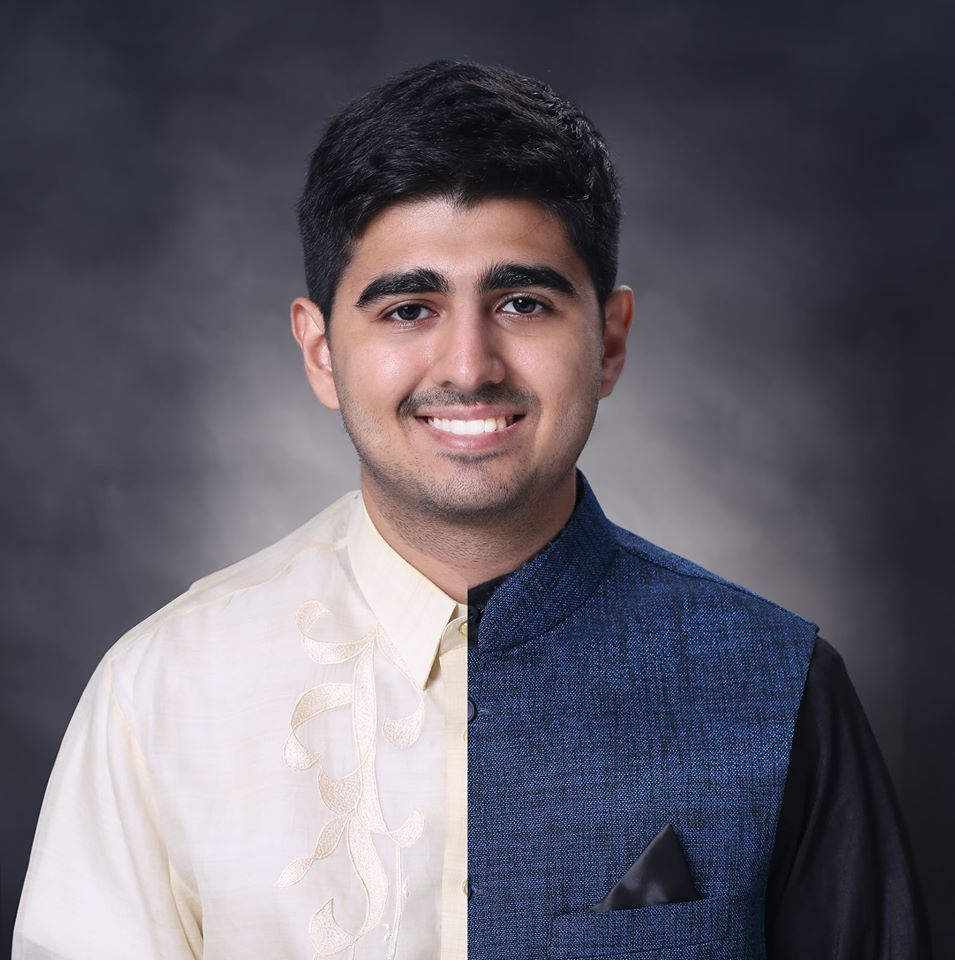
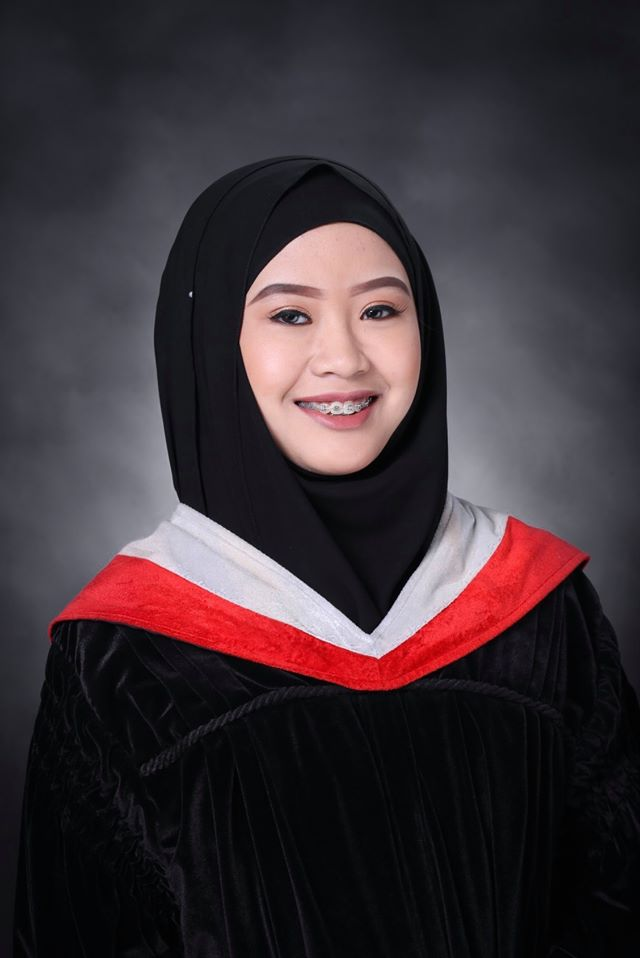
Ensuring inclusive education program success requires an evaluation of the…
Professor Maria Alexandra I. Chua, PhD, Dean of the Conservatory…
How have Filipinos expressed grief alongside the technological means available…
The University of Santo Tomas Rector, Very Rev. Fr. Richard…
Ensuring inclusive education program success requires an evaluation of the…
Professor Maria Alexandra I. Chua, PhD, Dean of the Conservatory…
How have Filipinos expressed grief alongside the technological means available…
The University of Santo Tomas Rector, Very Rev. Fr. Richard…

The University of Santo Tomas is one of the leading private research universities in the Philippines and is consistently ranked among the top 1000 universities in the whole world. With academic degrees and research thrusts in the natural, health, applied, social, and sacred sciences, as well as business and management, the University continuously strives to make a positive impact on the society.
Visit Us:
Espana Blvd., Sampaloc, Manila, Philippines 1008
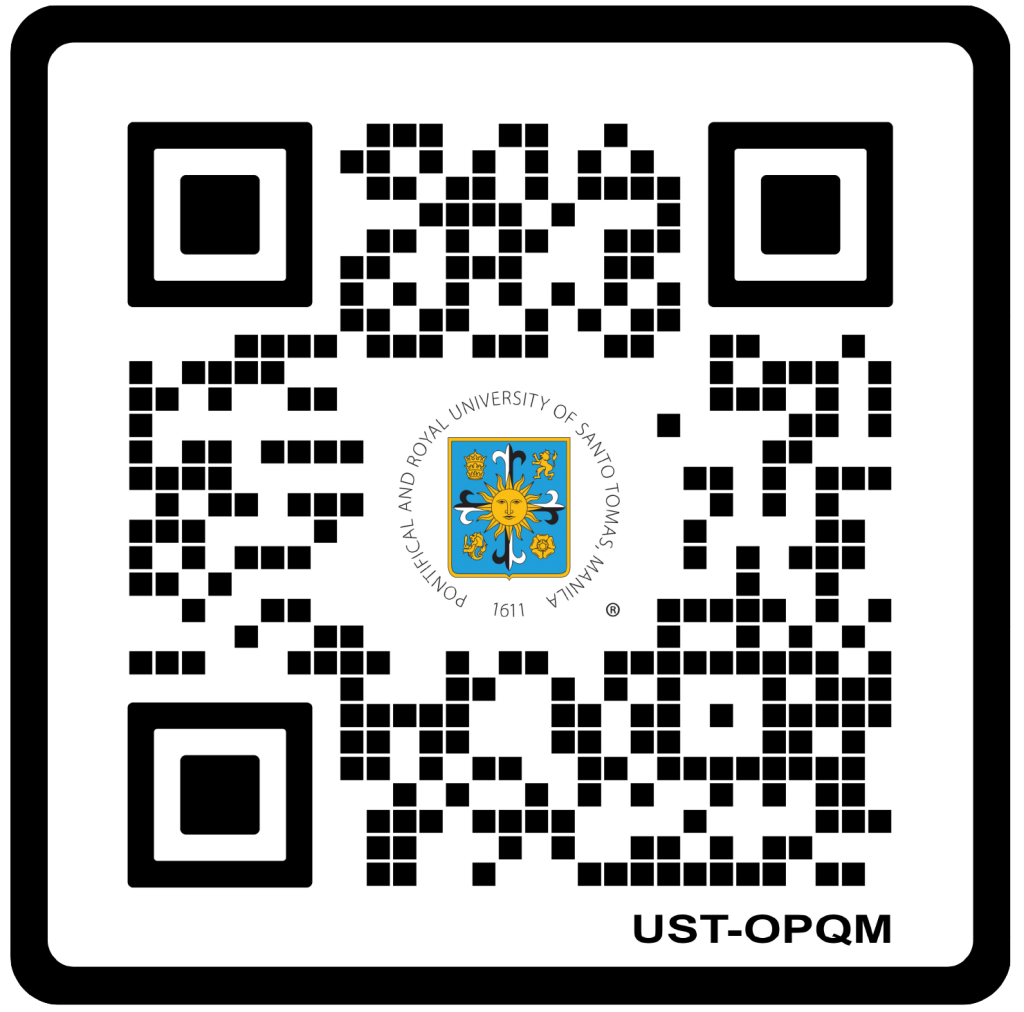
© Copyright 2019. University of Santo Tomas. All Rights reserved. | Powered by Communications Bureau